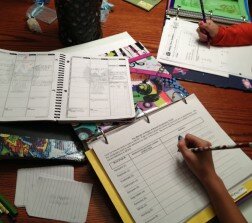How to Teach Kids Organizational Skills For School
Posted on: Friday, February 8th, 2013

School is not how it used to be. How many parents have muttered those words once their child starts grade school? The curriculum is more difficult, the projects are more sophisticated, and the amount of homework can seem impossible to tackle. It has become a necessity for students to learn organizational skills and project management at a young age. I remember using a single 5 subject notebook for all of my schoolwork. My kids take home multiple colored folders and binders filled with dividers. All of this to manage the new load of responsibilities current students have: classwork, projects, homework, drills, reading logs, standardized tests, unit tests, performance tasks, flash cards, book talks, etc. The list goes on and on. So how can you help teach your students to organize all of this?
Eight Organizational Tips to Teach Children (the earlier the better!)
Bring all materials to school. Ingrain in your children the importance of being prepared with materials. This includes pencils, pens, erasers, every notebook, every binder, and every textbook. Forgetting items at home has significant impact on the child’s ability to successfully approach their school day tasks and responsibilities. Have your child create a checklist of all required items, type it, and paste it to the front of a planner (if they have one), or keep in the front pocket of his/her backpack. They should review this list before they leave for school or go home at the end of the day to ensure they bring every item they need.
Pack the backpack the night before. After your child finishes his/her homework for the evening, make sure he/she packs up all of the items they’ll need for the next day (including projects, reports, and homework to turn in) are placed in the backpack. This avoids confusion and panic for the next morning.
Complete homework and projects in the same public area in the home at the same time each day. This homework area should be quiet and free from distractions (video games, TV, etc.). Providing this structure will help children stay on task and help prevent procrastination. Making it a public area in the home will ensure that you can help keep your child on task as compared to if they were studying in their own bedroom by themselves.
Use a planner. If your child’s school doesn’t provide one, find a planner at your local office supply store. Make sure the planner has a monthly calendar view and weekly view with plenty of space to list homework and tasks. Writing down all homework and assignments will help the child recognize the amount of responsibilities they need to be accountable for as well as help ensure they get them done in a timely manner. If the child has a smartphone or iPod Touch, he/she can easily find apps such as Remember the Milk and Jorte that include calendar day lists and long-term planning.
Set timely goals and tasks for projects and long-term assignments. Every time your child has a big project, teach him/her to identify the due date and end product in order to work backwards in planning what needs to be done. This should be done in the planner. By starting with the due date, the child will see how much time they have to complete the tasks. Then they should decide on how they can divide up the tasks to fulfill the project appropriately throughout that time frame.
Set timely goals and tasks for weekend homework (if any). Just as you do for projects and long-term assignments, teach your child to map out what work they have to do over the weekend. On Friday afternoon, have the child take out all of their school work and their planner. They should identify what homework, studying, and/or project tasks they have to do during the weekend. Then they should assign these responsibilities in the appropriate day (Friday, Saturday, or Sunday) with a realistic expectation.
Clean out and organize school binders and backpack every weekend. It can be easy for children to easily get disorganized with their notebooks and backpacks. Have the child organize needed papers and throw out scratch paper weekly before any disorganization gets out of hand!
Study class notes every night. If the child is at the age where he/she receives notes on content daily, they should get into the habit of taking 10 -15 minutes or so reviewing notes. This helps reinforce concepts that are currently being taught, identify topics that the child may need extra help with, and prepares them for upcoming assessments.
These organizational tips will require parental support and supervision initially. However, if you stay on top of the child with these responsibilities for a period of time after introducing them, kids will eventually acquire these organizational skills as habit. You need to slowly wean them from depending on your reminders and prompting. The child needs to be held accountable, not the teacher or parent. As a consequence, the child will grow up being able to spend more time on learning and less on cleaning up disorganization.
Author – Lani deGuia is an instructional technologist for k-12 education and has been in education for almost 12 years. She is interested in teaching and helping others exploring the world! She is author of http://www.rosetintedtraveler.com/

